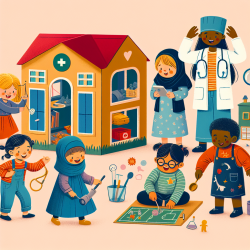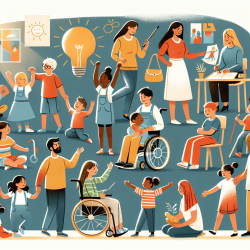In the field of special education, particularly when working with children who have language disorders, the importance of effective intervention strategies cannot be overstated. A critical area often overlooked in traditional language intervention programs is the role of pretend play in language development. Pretend play is not only a natural activity in which children engage but also a potent context for language use and development. This blog post delves into the significance of modeling in enhancing the verbal elaboration of pretend play among children with language disorders, drawing insights from the study "The Effects of Modeling upon the Verbal Elaboration of a Language Disordered Child's Pretend Play" by Elizabeth Skarakis-Doyle and Sandra Woodall.
The study explores the impact of a modeling procedure on the verbal elaboration of common event scripts in pretend play, focusing on two types of language: verbal invention and active other directed. These forms of language play crucial roles in defining roles, creating props, actions, and actors, and thus, in enriching pretend play. The findings revealed that modeling effectively increased the target behaviors, offering valuable implications for clinical practice.
Modeling, as demonstrated in the study, is a technique where a therapist or educator demonstrates specific behaviors, hoping the child will imitate and incorporate these behaviors into their own play. This technique aligns with social learning theory, suggesting that children learn behaviors through observation and imitation of others. The study's success in using modeling to enhance pretend play in a child with a language disorder underscores the potential of this technique in special education and speech therapy contexts.
Implementing Modeling in Practice
Practitioners aiming to incorporate modeling into their intervention strategies might consider the following approaches:
- Structured Play Sessions: Design play sessions that include a variety of scenarios and scripts. Use toys and props that are relevant to the child's experiences and interests to make the play more engaging and meaningful.
- Active Participation: While modeling is primarily about demonstration, encouraging the child's active participation during the session can enhance learning. Invite the child to join in the play, prompting them to use the modeled language and behaviors.
- Repetition and Variation: Repeating the modeled scripts across sessions helps reinforce learning. Introducing variations in the scripts can also promote flexibility and creativity in the child's use of language during play.
- Emphasize Verbal Inventions: Focus on modeling verbal inventions—creating pretend objects or scenarios through language. This encourages the child to use language creatively, expanding their linguistic repertoire.
- Encourage Role-Taking and Active Other Directed Language: Model and prompt language that attributes actions, needs, or feelings to characters in the play. This type of language fosters social understanding and empathy.
Challenges and Considerations
While modeling presents a promising avenue for enhancing language development in children with language disorders, practitioners should be mindful of several challenges:
- Individual Differences: Children with language disorders have diverse needs and abilities. Tailoring modeling sessions to the individual child's developmental level and interests is crucial for effectiveness.
- Maintaining Engagement: Keeping children engaged in structured play sessions can be challenging. Sessions should be designed to be fun and motivating for the child, using themes and activities that capture their interest.
- Generalization: One of the goals of modeling is to help children generalize learned behaviors to new contexts. Practitioners should provide opportunities for children to apply modeled language and behaviors in various settings and situations.
Conclusion
The study by Skarakis-Doyle and Woodall highlights the potential of modeling as an effective technique for enhancing the verbal elaboration of pretend play in children with language disorders. By incorporating modeling into intervention strategies, practitioners can provide children with the tools they need to expand their language use within the rich context of pretend play. This not only facilitates language development but also supports broader cognitive and social skills essential for communication and learning.
For practitioners interested in exploring this technique further and seeking to implement it in their work, the study offers a foundational understanding and practical insights into the benefits of modeling in language intervention. As we continue to seek innovative and effective strategies to support children with language disorders, modeling stands out as a valuable tool in the special education and speech therapy toolkit.
To read the original research paper, please follow this link: The Effects of Modeling upon the Verbal Elaboration of a Language Disordered Child's Pretend Play.










